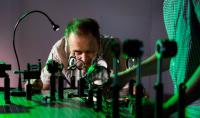"Star Wars" lens

Researchers from the Faculty of Physics cooperate with the Military Medical Institute and the Research and Analysis Department, photo: CZIiTT PW
Can scientists find inspiration for their work in popular culture? Yes, of course! This occurred in the case of a WUT Faculty of Physics project. George Lucas' films inspired researchers to develop a solution that can help improve the vision of the elderly.
The unique "Light Sword Lens" is this solution. As early as in the previous century, Andrzej Kołodziejczyk, Maciej Sypek, and Zbigniew Jaroszewicz, today's professors, examined the diffraction elements that formed unusual light distributions, and came up with the idea of designing such structures that will bend them into a segment resembling a sword blade. The source of inspiration was none other than "Star Wars". In a paper published in 1990 (co-authored by Salvador Bará of the University of Santiago de Compostela), they were the first to introduce the concept of a light sword into scientific literature.
This idea has potential!
The "Light Sword Lens," unlike ordinary lenses, focuses light into a segment across a certain distance, creating a form of a blade. Researchers have treated this element as a curiosity for a decade.
– Until, as part of our master's thesis, we were tasked with examining the possibility of imaging using three structures: the so-called peacock's eye, axons, and a light sword. – recalls Krzysztof Petelczyc, PhD, from the Faculty of Physics.
During the course of the project, it turned out that it was the "light sword" lens that offered the best chance for obtaining high-quality imaging with enhanced depth of field.
Further study focused on the lens's specific application, which is the correction of presbyopia, a condition in which the eye loses its ability to accommodate. A child's eyes can focus on objects up to 10 cm away and then properly view objects at any greater distance. As we get older, this minimum distance of vision, or near visual acuity, becomes increasingly distant from us. And, while the rate of these changes decreases significantly after the age of fifty, one condition - the cataract - overlaps the other.
The lens, which, due to its distinctive geometry, would allow sharp vision from any distance - when reading a book, conversing face to face with friends, or admiring mountain scenery - would help to remove the obstacles to clear vision.
Strength in cooperation
Not only engineering, but also medical knowledge is required to develop the idea. That is why the WUT researchers collaborated with the Military Medical Institute. Thanks to this partnership, it was possible to make the first attempt at a pre-clinical testing.
– We applied the prototype of a plastic light sword in the form of glasses close to the pupil, – says Petelczyc, PhD. – Technically, this is not the correct way to use the sword, which can only be used as a contact lens or intraocular implant to replace a natural eye lens after cataract surgery.
For this, however, you need a light sword made of biocompatible material. Only then could the target form, that is intraocular implant, be considered.
The establishment of cooperation with the Research and Analysis Department (DBA) of the WUT Centre for Innovation and Technology Transfer Management by the team of Petelczyc, PhD, was an essential stage in the development of the research. It was there that our researchers obtained assistance in the fields of psychology and sociology methods required to adequately measure human impressions. The Perceptual Research Laboratory (Laboratorium Badań Percepcyjnych), established jointly by DBA and the Faculty of Physics in collaboration with a team from the Military Medical Institute, creates the potential to take on the challenge of conducting clinical trials and commercialization of developed solutions.
Tests on the artificial eye model revealed that, when compared to the intraocular implants that are currently on the market, the solution developed by the Faculty of Physics offers more uniform and thus more comfortable vision. We will have to wait for these observations to be confirmed until a functioning implant is developed.







